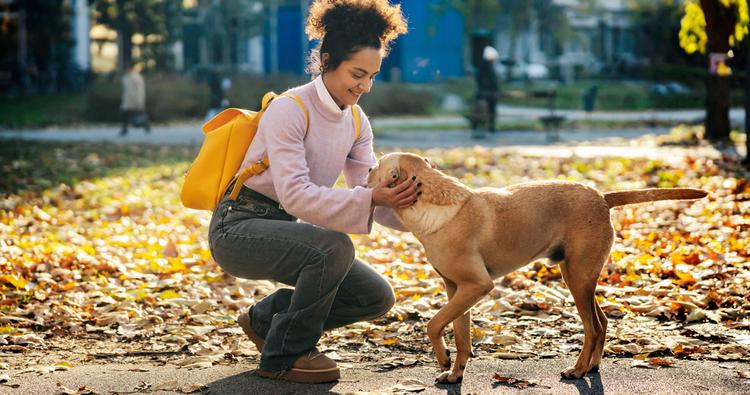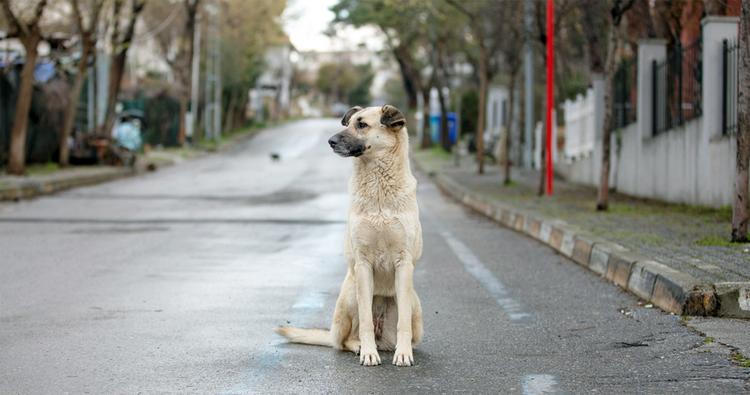Lost Dog? Use Our Lost-or-Found Poster Template to Bring Them Home
Here’s how to make an effective lost dog poster — whether your pet is missing or you found a stray pup — and increase the chances of a safe homecoming
Here’s how to make an effective lost dog poster — whether your pet is missing or you found a stray pup — and increase the chances of a safe homecoming
by Katie Koschalk, | April 15, 2024

cottonbro studio / pexels
When anyone’s beloved dog goes missing, time is of the essence in spreading the word and increasing the chances of a safe reunion. A well-designed lost-dog poster is a powerful tool that provides critical information about your pet (or someone else’s) and captures the attention of people in your community.
But what should you put on your poster? Here, we detail the essential elements to include, providing a simple but effective lost-dog poster template you can download and customize. Plus, we’ll give you extra tips for finding a lost dog and preventing your curious pooch from escaping in the first place.
Hopefully, you won’t ever have to make a lost-dog flyer. But in the unfortunate event you do, here are some best practices. First, you’ll want to print your posters in two sizes.
Large posters (11” x 17” or larger): Hang these around your neighborhood and the area where your dog was last seen.
Smaller, flyer-size posters (8.5” x 11”): Pass these out directly to neighbors, or display them on bulletin boards at veterinary clinics, grocery stores, coffee shops, community centers, etc.
If possible, print the posters and flyers on colorful, eye-catching paper. But be sure that the chosen color is light enough that your black text is easily readable. Here’s what to include on the posters and flyers.
The headline serves as the initial attention-grabber, compelling passersby to notice and engage with the poster. Keep it clear, concise, and descriptive. For example: “Lost Black Lab” or “Lost Husky Puppy.” Make sure the text is large, bold, and easily readable.
A recent, high-quality photo of your dog is perhaps the most crucial element of the poster. This image serves as the primary means of identification for people who may spot your pet. Ensure that the photo accurately captures your dog’s appearance, including their facial features, coat color, and any distinguishing markings or features.
Pro tip: Take frequent pictures of your dogs, so you always have up-to-date images to use.
Include your dog’s name, breed, color, and any unique characteristics or features that can help distinguish them from other dogs in the area.
Example:
Bella, Golden Retriever, 9 years old, 45 pounds
Gold, white around eyes and muzzle
Small notch on bottom of left ear
Specify the date and precise location where your dog was last seen. This information helps community members focus their search efforts in the right areas. Be as specific as possible when describing the location, including nearby landmarks or intersections.
Clearly display your phone number and email address on the poster.
If you’re offering a reward for information leading to your dog’s safe return, include the amount on the flyer. A reward can encourage people to keep an eye out for your missing dog or actively participate in search efforts. Be cautious when offering a reward, though, and be wary of potential scams or false leads.
What if you find a dog that appears to be lost? Here’s what to do:
Try to secure the dog: If the dog is approachable and friendly, attempt to leash them (if you have one handy), and get them to a secure location, such as a nearby business or your car or house. Use caution when handling unfamiliar dogs, as they may be frightened or defensive.
Check for identification: Next, look for any visible identification tags or a collar on the dog.
Notify local authorities: Contact your local animal control to report the dog. Provide them with a detailed description and any identifying information you’ve gathered. They may be able to assist in locating the dog’s guardian or provide guidance on next steps.
Create a found flyer: For the dog’s safety, only include enough information so that the pet’s family will suspect the dog is theirs. For instance, if you find a black French Bulldog, you might advertise “Found: Small Black Dog.” When someone calls, ask them which breed their dog is. You want to do everything you can to ensure anyone claiming to be their family actually is. Display these posters in prominent spots in the area where the dog was found.
When you’ve just lost your dog and are in a panic, you might struggle to figure out the best flyer layout for maximum impact. To make things easier and more efficient for you, we created a lost dog poster template that you can download and edit to include your information.
A found dog poster can help spread the word about the lost pet. To make things easier and more efficient for you, we created a found dog poster template that you can download and edit with information about the found pet.
Losing your pet is a gut-wrenching experience, but with the right approach and strategies, you can increase the likelihood of a successful reunion. Here are some tips to help you find your lost pup.
Begin your search immediately after realizing your dog is missing. Start by thoroughly searching the area where your dog was last seen. Dogs often stay close to familiar territory, so check nearby streets, parks, and favorite spots where your dog may frequent.
Ask neighbors to check their garages, sheds, backyards, or any other good hiding spots on their property where a scared dog might seek refuge. Initiate a conversation with everyone you encounter, whether it’s your mail carrier or a jogger, as they may have seen your dog.
It can also help to post about your lost dog on social media (Instagram, Facebook, etc.) or community websites like Craigslist (post under “pets” and “lost & found”), Pawboost, and Nextdoor. Include photos or videos of your dog, a description, information about where they were last seen, and your contact info. Regularly monitor these platforms for any updates or sightings.
Don’t hesitate to ask for assistance from family, friends, neighbors, and even strangers in your community. The more people you involve in the search, the greater the chance of someone spotting your dog or providing valuable information.
Notify your local humane society about your lost dog. Provide them with a detailed description of your dog and regularly check their databases for any found animals that match your dog’s description.
As you’re searching, secure your posters anywhere that’s legal. It’s not always legal to hang posters on telephone poles, so check the laws in your area. Many people do it anyway, but know they might be removed if it’s illegal.
Another idea is to mount your posters on cardboard and attach them to wooden stakes. Ask property owners in high-traffic areas for permission to put the stakes in their front yards.
While you’re doing that, ask a family member or friend to hang flyers on community bulletin boards.
Remain persistent in your search efforts, even if days or weeks pass without any leads. Keep searching, networking, and spreading the word, as it’s not unheard of for lost dogs to be successfully reunited with their families even weeks or months after they disappear.
If your search efforts haven’t brought your pup back home, consider hiring a professional pet tracker to assist in locating your lost dog. These professionals have experience and resources that can significantly aid the search process.

Oleksandra Stets / Stocksy
While losing a dog is often beyond your control, implementing proactive measures to prevent escape can significantly reduce the likelihood of such situations. Let’s review some effective strategies to keep your dog safe and secure.
Ensure your yard or outdoor space is securely fenced to prevent your dog from wandering off. Regularly inspect the fence for any gaps, holes, or weak points that could allow your dog to escape.
Also, secure inside doors and windows, and install self-closing and self-locking mechanisms on doors and gates to ensure they remain closed at all times. Teach family members and visitors to be mindful of closing doors and gates behind them, to prevent your dog from slipping out.
Keep a close eye on your dog whenever they’re outdoors, especially if they’re prone to wandering or exploring.
Keep a particularly close eye on newly adopted dogs. During their adjustment period in a new home, newly adopted dogs (especially rescue dogs) may have a strong instinct to find something familiar (even if what’s familiar isn’t so nice). This means they may be drawn to places or scents from their past, which could potentially lead them astray. You have to develop a bond with your new dog before you can trust them to not bolt at the earliest opportunity.
Invest time in training your dog to respond to commands like “come” and “stay.” Obedience training can help instill discipline and prevent your dog from running off when they encounter tempting distractions. Practice recall exercises regularly in a controlled environment to reinforce good behavior.
Dogs experiencing separation anxiety may attempt to escape in search of their guardians. Take steps to address separation anxiety through behavior modification techniques and desensitization training. Enlist the help of a professional if needed.
Make sure your dog always wears a secure collar with an up-to-date identification tag containing your contact information. Additionally, consider microchipping your dog as a permanent form of identification. If your dog escapes and is turned into a vet clinic or shelter, the employees can scan the microchip to get your contact information.
Provide your dog with plenty of mental and physical stimulation to reduce their desire to escape due to boredom or restlessness. Provide regular walks, play sessions, and interactive toys to keep your dog mentally stimulated and satisfied. A tired, happy dog is less likely to seek out opportunities to escape.
Absolutely! The templates can be easily adapted to find lost cats (or other animals) as well. Simply replace references to “dog” with “cat” and adjust any specific details accordingly.
Create missing dog posters and flyers as soon as your dog goes missing. You can also fill in details before your dog goes missing. This proactive step ensures you’re well-prepared to act swiftly if your dog ever becomes lost.
If you encounter a stray dog, approach them calmly and check for identification. If safe, secure the dog and provide temporary shelter while contacting animal control. Spread the word online to locate the guardian or find suitable care.
If you find a cat that you think is lost or in need of help, approach them calmly and check for identification. If possible, take the cat home with you. Then, call animal control and post about the cat online to see if anyone has reported a missing cat matching the description.
Dogs may attempt to escape your yard due to boredom, curiosity, lack of exercise, fear, prey drive, or territorial behavior. Secure your yard to ensure your dog cannot escape, and regularly inspect the perimeter for gaps, holes, or weak points that your dog could get through.

Katie Koschalk is a freelance writer based in Northern California. Fusing her love and knowledge of animals with her journalism degree and years of professional writing, Katie is dedicated to improving the lives of pets and their caretakers by sharing helpful and accurate information. When she’s not at her desk, you can find her exploring trails with her Aussie, Hunter, cooking plant-based meals, and talking to her two cats, Jax and Sadie, in really ridiculous voices.

Rehome

Rehome

Rehome


Shelters & Rescue
Found a stray dog in your neighborhood? Read more to learn how to help safely.